Quality content takes time and effort to produce. I am sure you know this if you regularly publish content on all your distribution channels.
But many brands lose quality in pursuit of higher quantities of content.
While I agree that quantity is important as well, your quality can’t suffer as a result of this strategy. You need to learn how to avoid stale content.
I work with many businesses that run into this problem. They want to publish at least one piece of content a day on all their distribution channels.
Among their websites, blogs, and social media pages, it’s a lot of content. Before you know it, that’s upward of 30 posts per week across these platforms.
However, that doesn’t mean you need to come up with 30 unique pieces of content. This approach will take too long and ultimately hurt your quality.
That’s why you need to learn how to effectively repurpose your content across multiple marketing platforms.
First, you need to learn the top ways to come up with new content ideas.
Once you have an idea, you can turn it into multiple posts on each channel. In fact, sometimes you won’t even need to come up with a new idea. You can use old content to your advantage here as well.
Worker smarter, not harder.
As we continue through this guide, I’ll explain how you can repurpose your content across all your distribution channels and give you some ideas to try.
Identify your most popular content
Before you spend time producing new content, I recommend re-using older publications and posts.
After all, you already spent time working on these. Why let them go to waste?
But don’t just use any content. Start with your most popular pieces.
Identify your content with the highest engagement rates. Look for:
- Facebook likes
- retweets
- posts with the most page views
- email newsletters with the highest click-through rates
If you’re struggling to find what you need, try using Buzzsumo to see which content had the highest engagement on social media. Here’s what the content analyzer tool found when I put quicksprout.com into it:
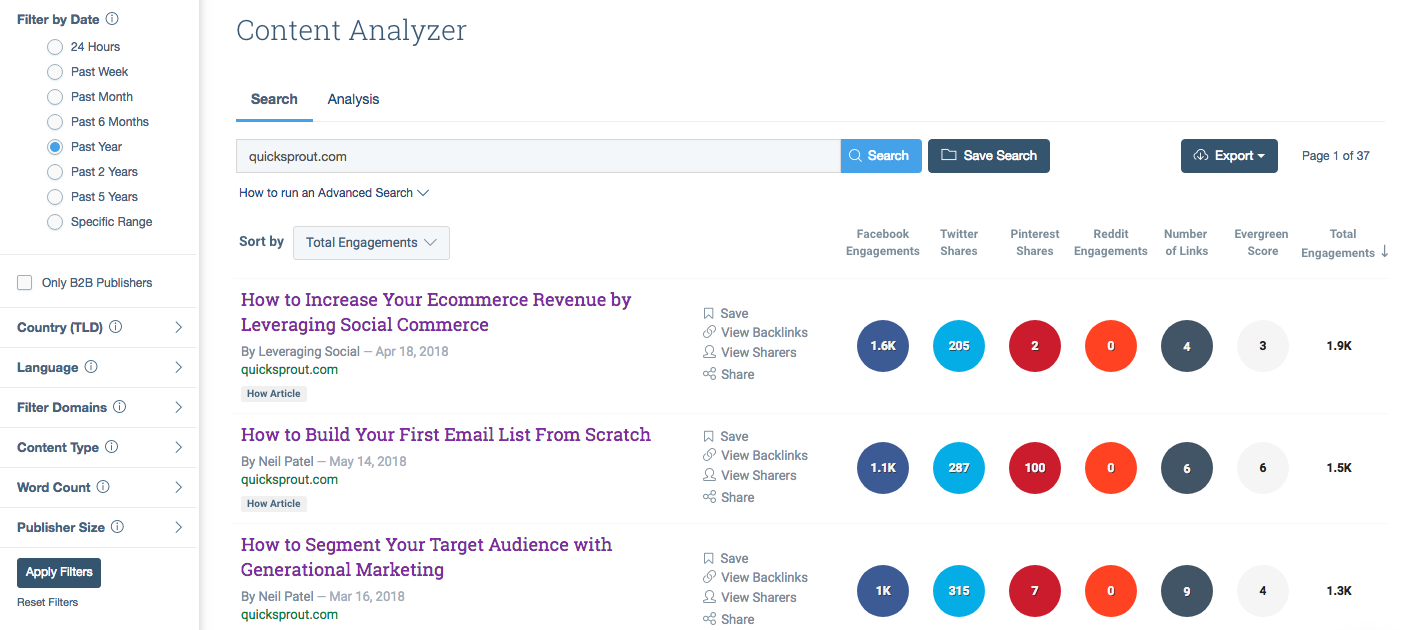
It shows me which posts from the past year were the most popular. But you can filter the time based on your needs.
In addition to Buzzsumo, you can use Google Analytics to see which pages on your website are the most popular.
After you analyze your content with these tools, make a list of your top performing publications and posts.
This will be your starting point. You’ll use this list to repurpose content.
For example, if you had a high performing blog post, you can turn it into a YouTube video. You could use a Facebook post with the highest number of likes on your Instagram story.
The ideas are seemingly endless. As we continue, I’ll give you some more examples of how you can proceed.
Build custom infographics
Going through your old posts, you want to find ways to repurpose them for even more engagement.
Here’s what I mean.
If you take an email newsletter that had the highest number of opens, click-throughs, and conversions and turn it into a blog post, the idea is that the blog post will be high-performing as well.
Otherwise, what’s the point? You don’t want to publish content just for the sake of publishing.
Your content needs to be actionable and drive engagement.
That’s why infographics are ideal for this strategy. Infographics are the most shared types of content across social platforms:
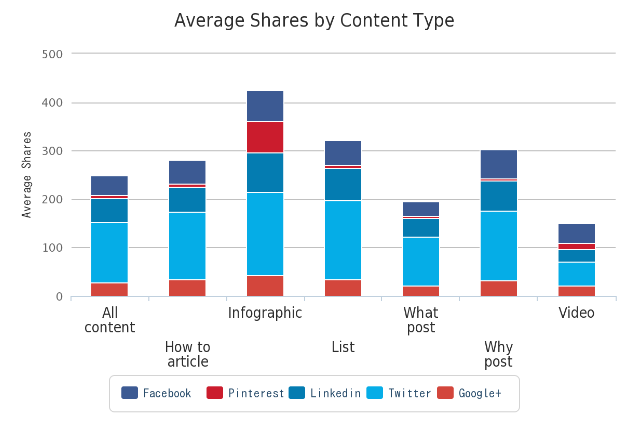
People are visual learners.
The graph above is a perfect example of that. Sure, I can tell you infographics get shared the most. But when I show you, it really sinks in and makes it easier for you to process.
Scan through all your top performing posts you identified earlier. Look for facts, statistics, or anything else that could be turned into a visual representation of the concept.
If you have never built an infographic before, don’t be intimidated. It’s not that difficult.
Refer to my post on how to enhance your content by building infographics for a list of tools that will make this process easy for you.
Once you create these infographics, you’ll have many options.
The same infographic can be used in different ways. You can:
- add it to the original blog post, which can be republished
- share it on social media
- add it to your email newsletter
- place it on your website
- use it in a video slideshow
The list goes on and on.
Leverage your social media platforms
Your social media profiles have lots of benefits. They expose your brand to a wider audience and help you engage with your followers and customers alike.
Posting content on social media also helps you drive traffic to your website.
Anything you create gives you an excuse to post on social media.
If you haven’t been doing this, you need to do so moving forward. All your videos, infographics, and pictures are a must.
Social media is the number one way for publishers to drive traffic to their blog posts:
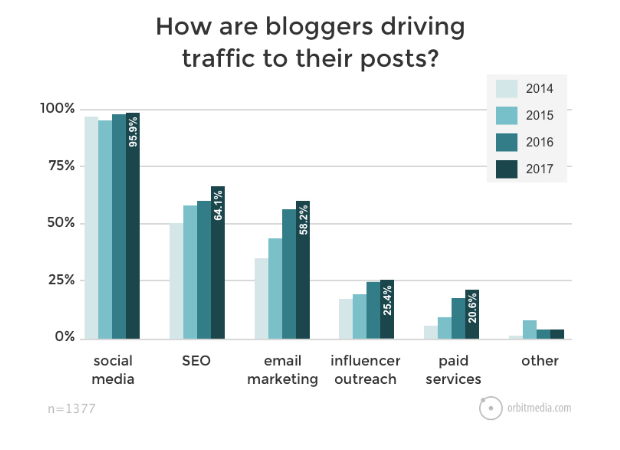
If you look at my Facebook page and my Twitter profile, you’ll see I use this strategy for all my blog posts.
It’s easy. Plus, it gives you an excuse to post something every day.
I’m shocked whenever I see businesses not using this tactic. They publish three or four blogs per week but struggle to come up with social media posts.
When you implement this strategy, plan your posts accordingly.
For example, there’s no reason to share the same blog post on all your social platforms simultaneously.
Spread out those promotions throughout the week. This will maximize your exposure and increase the chances of driving more traffic to your site.
Create more evergreen content
You can’t repurpose old content forever. At some point, you’ll need to create new pieces.
But you can make repurposing easier by creating evergreen content.
Are you familiar with this concept? Allow me to explain.
Simply put, evergreen content stays relevant for longer periods of time than regular content. Ideally, the majority of your content will be evergreen.
But it’s not realistic or likely that this will be the case for everything you create.
For example, last year, I wrote a post on top marketing trends to look for in 2018. Once 2019 comes, this post will lose its freshness.
When you write your evergreen content, you want to be as broad as possible. This post was fresh for an entire year. That wouldn’t be the case if it was the top trends to look for in January 2018. Do you see the difference?
Extremely specific content will only be relevant for a short period of time. Therefore, it’s more difficult for you to repurpose it.
Here’s another example. If you write a post about the Apple’s latest iOS update, it’s fresh only until a new version of the software is released. That’s not evergreen.
Here are some tips to help you find an evergreen topic:
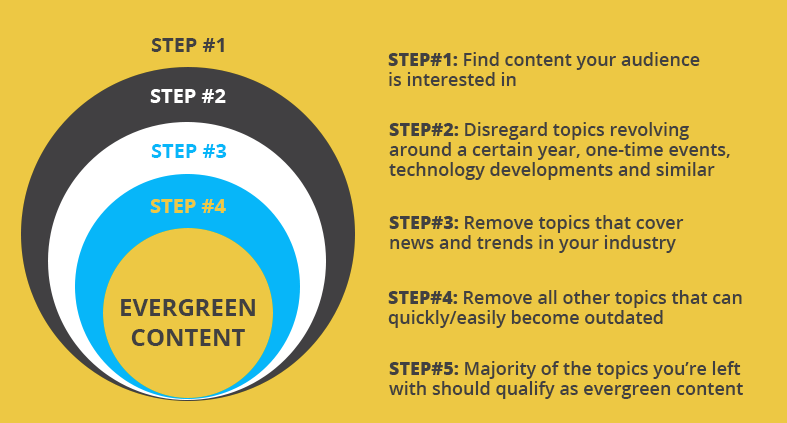
FAQ sheets are great for evergreen content.
Produce how-to guides or videos on topics that won’t be changing for years.
Clarify industry terms and concepts.
Again, I’m not saying you should be producing only evergreen content. That’s not realistic.
But if you publish an evergreen topic tomorrow, you could potentially repurpose it on another platform next year. That’s the idea.
Find the most interesting statistics you published
If you’re like me, you use statistics in your content all the time. Stats are a great way to back up any claims you’re making.
I recommend doing this because it proves your legitimacy and lets your audience know you’re not making things up.
But if you’re not repurposing content, those statistics get buried in your posts after they are published, never to be seen again.
Go back, and find the most interesting ones. In the future, keep a list of all statistics when you find them.
Then you can use them on other platforms.
Earlier, I talked about creating infographics. But that’s not the only way you can repurpose data.
Tweet a statistic. Use them in your Instagram captions. Include a stat in your email subject line. Post the most relevant ones on your website.
Get creative with this strategy.
Start a podcast
Podcasts are another great way to repurpose your content.
That’s because you have many different resources to work with there. All your blog posts and YouTube videos are viable options for a podcast.
You can summarize this content, nearly word for word, with your podcasts.
Since podcasts are growing in popularity, it’s a great way to reach an audience that doesn’t want to read blog posts or watch videos:

Consider bringing a guest on your podcast to make things more interesting.
Have some fun with it. I try to keep this in mind with all my podcasts.
Fine-tune your writing skills
If you’ve got lots of audio, video, and visual content, you need to learn how to turn that into written content.
Start blogging more often. Write every day if you can.
It’s like anything else. The more you do something, the better you’ll get at it.
I wasn’t born a great blogger. It’s a learned skill.
Are some people better writers than others? Absolutely.
If you can’t find the time to write or can’t figure out how to write quality content, find someone on your team who can handle these responsibilities.
Once you’re able to write better, you can write a blog post about one of your YouTube videos, for example.
Keep things simple. Make your content easy for people to read and understand.
These are just some examples of things you can turn into written content:
- webinars
- podcasts
- speeches from industry events
- interviews
Encourage user-generated content
Your content isn’t the only type you can repurpose.
If you can find creative ways to encourage user-generated content, it will be easy for you to use this to your advantage as well.
Then all you have to do is sort through that user content and find the best pieces to repurpose for your needs.
Here’s an example of how GoPro encourages UGC on its website:

As you can see, it offers an incentive for people to submit their own content.
GoPro is giving away a million dollars, split between anyone who submits content that the company uses in a promotional video.
This saves the team a ton of time.
Instead of going out to different locations all over the world to shoot videos on their latest camera model, they put their customers to work instead.
Plus, they’ll be able to get way more footage this way as opposed to trying to do this on their own.
Once the videos are submitted, GoPro can repurpose them in a bunch of different ways. They can be used for advertisements, social media posts, YouTube videos, website content, and they can even be embedded in emails.
Come up with a similar strategy, and encourage your customers to submit pictures and videos.
I recommend using social media as a distribution platform for your UGC campaigns.
You can also find UGC without asking for it.
Sift through your comments.
Look at the comments on your social media pages and blog posts to see which ones can be repurposed.
If you notice similar comments or questions, use them to create an FAQ page.
Find your strongest introductions
Sometimes, all you need to do is repurpose a portion of your previously published content.
If you want to repurpose a short form of written content, I recommend using your post introductions.
If you need help with this, learn how to write blog post introductions that make the rest of your post irresistible.
Once you identified these top introductions, it’s easy to repurpose them.
Use an introduction from a blog post in an email newsletter. Use the same text in a YouTube video description.
Preview your introductions on social media. Here’s an example of how Conversion XL uses this strategy:
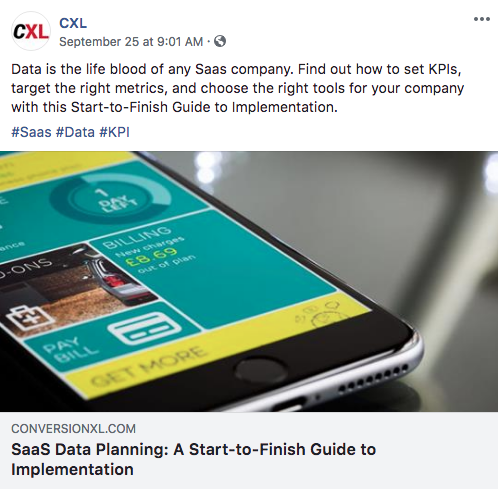
This also connects to one of my previous topics about leveraging your social media platforms.
Rather than posting a link with a CTA such as “check out my latest blog post,” consider using this strategy instead.
The text associated with the link would be the opening lines of the blog post introduction.
Conclusion
You don’t need to create new content every time you want to publish something new.
There are ways for you to use your existing content to your advantage. Just repurpose the work you’ve already done across all your distribution channels.
Start by identifying your best content. You’ll want to use that to increase your engagement metrics.
Build infographics. Share statistics. Post everything on social media.
Moving forward, create as much evergreen content as possible. This will make it easier for you to repurpose your content in the future.
Turn blog posts into podcasts. Use videos and other audio files to create posts.
Encourage user-generated content so you can repurpose it.
As you implement these strategies, you’ll realize you’re currently sitting on enough content to last you for months to come, as long as you can repurpose it effectively.
Use this guide as a reference to steer you in the right direction.
from Quick Sprout https://ift.tt/2FzlZZt
via IFTTT
